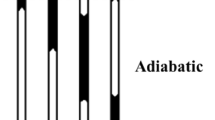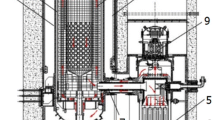Abstract
Background
Superconducting cavity is usually needed to be gradually cooled from room temperature to the superconducting temperature zone (4.2 K and below) in the testing and sophisticated operation process of superconducting cavity.
Purpose
The purpose of this paper is to study the cooling law on the helium cooldown process for the 650 MHz two-cell superconducting cavity with the unsteady numerical simulation.
Method
A three-dimensional coupled heat-flow model of 650 MHz two-cell superconducting cavity was established. The unsteady numerical simulation of different inlet temperatures, flow rates and pressure conditions was carried out. The equivalent convective heat transfer coefficient and temperature distribution of 650 MHz two-cell superconducting cavity during cooldown process were obtained. The effects of cooling time and entrance parameters on the cooldown process were analyzed.
Results
The temperature distribution of the lower intersection lines has a large drop in the initial stage of cooldown process (120 s), while the temperature near the flanges at the both ends is still higher (remaining at the initial temperature of 300 K). With the passage of time, the temperature of the upper and lower intersection lines decreases. The maximum temperature difference on the lower intersections is within 2 K in the final stage of cooldown process (3600 s). The maximum temperature difference increases by 180%, and the difference between the maximum temperature and the minimum temperature (dT) at the end of a cooldown stage increases by 130% after 1 h, respectively, when the inlet temperature drops from 290 to 270 K (under the condition of the initial temperature of 300 K).
Conclusions
The maximum temperature difference and the dT at the end of a cooldown stage increase with the decrease in the inlet temperature. The maximum temperature difference increases with the increase in the inlet flow rate, while the dT at the end of a cooldown stage decreases with the increase in the inlet flow rate. The effect of changing the inlet flow rate on the cooling rate is not as obvious as changing the inlet temperature. Once there is a certain flow rate, the advantage of further increasing the flow rate to reduce the temperature of the superconducting cavity is not so great.


















Similar content being viewed by others
References
L. Bian, S.P. Li, Y.P. Liu, Measurements of static heat loss and unloaded Q0 on the BEPC II SRF cavities. Chin. Phys. C Engl. Version Z1, 166–168 (2008)
K. Jensch, R. Lange, Numerical simulations for the cool‐down of the XFEL and TTF superconducting linear accelerators, in AIP Conference Proceedings, vol. 710, no. 1 (2004), pp. 371–378
B. Petersen, S. Wolff, in Proceedings of the 18th International Cryogenic Engineering Conference ICEC 18, ed. by K.G. Narayankhedkar (Narosa Publication Mumbai Press, Delhi, 2000)
P. Duchesne, S. Bousson, S. Brault, P. Duthil, et al., Design of the 352 MHz, beta 0.50, double-spoke cavity for ESS, in SRF Proceedings, Paris, France (2013)
J. Knobloch, Advanced Thermometry Studies of Superconducting Radio-Frequency Cavities (Cornell University, New York, 1997)
J.M. Vogt, O. Kugeler, J. Knobloch, High-Q operation of SRF cavities: the potential impact of thermocurrents on the RF surface resistance. Phys. Rev. Spec. Top. Accel. Beams 18(4), 042001 (2015)
C. Multiphysics. COMSOL Multiphysics User Guide (Version 4.3a). COMSOL, AB (2012)
A. Romanenko, A. Grassellino, O. Melnychuk, D.A. Sergatskov, Dependence of the residual surface resistance of superconducting radio frequency cavities on the cooling dynamics around Tc. J. Appl. Phys. 115(18), 153 (2014)
M.A. Gusarova, M.V. Lalayan, N.P. Sobenin, et al., Multipacting simulation in ISAC-II superconducting cavities, in Proceedings of PAC, Vancouver, BC, Canada (2009)
Y. Pischalnikov, J. Branlard, R. Carcagno, et al., A technique for monitoring fast tuner piezoactuator preload forces for superconducting RF cavities, in Presented at Particle Accelerator Conference, United States (2007)
P. Zhang, Z. Hao, Z. Li, X. Zhang, Frequency pre-tuning of the 166.6 MHZ proof-of-principle SRF cavity for HEPS-TF, in 18th International Conference on RF Superconductivity SRF2017, Lanzhou, China (2017)
CryoComp rapid cryogenic design, 88 materials in the properties database. Thermal Analysis Software (Eckels Engineering Inc., Florence, SC, USA 1993–2012)
F.W.J. Olver, NIST Handbook of Mathematical Functions (Cambridge University Press, New York, 2010)
J.W. Baughn, S. Shimizu, Heat transfer measurements from a surface with uniform heat flux and an impinging jet. J. Heat Transf. 111(4), 1096–1098 (1989)
Author information
Authors and Affiliations
Corresponding author
Rights and permissions
About this article
Cite this article
Li, M., Chang, Z., Li, S. et al. Unsteady numerical simulation on helium cooldown process for the 650 MHz two-cell superconducting cavity. Radiat Detect Technol Methods 3, 60 (2019). https://doi.org/10.1007/s41605-019-0138-7
Received:
Revised:
Accepted:
Published:
DOI: https://doi.org/10.1007/s41605-019-0138-7




